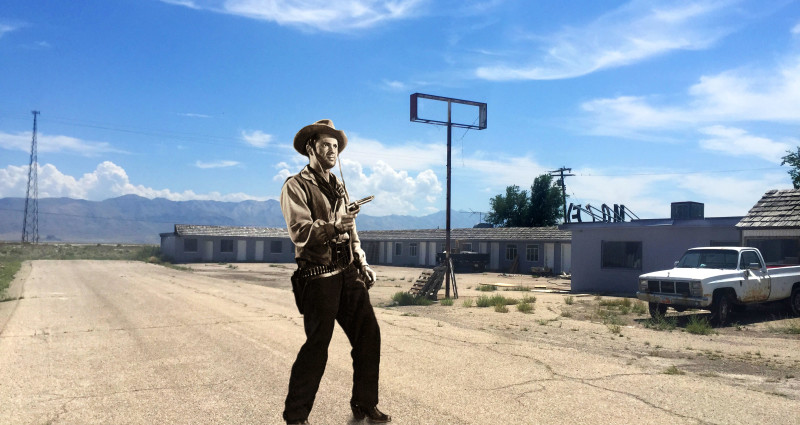
By Josie Luciano. The following review appears in the March 17, 2016 issue of The Reno News and Review.
“I’m upending a story that wasn’t true and never happened,” said Tom Judd.
He believes that the West, the frontier, and the stories that surround it are part of a mythology that’s worth a more cynical look. In Home on the Range, now showing at Stremmel Gallery, the Philadelphia-based artist subverts one vintage perspective (the myth of the frontier) with another (painting). The resulting work is sad, funny and, above all, weird.
“One of the reasons the story of the West is so weird is because people are so weird,” said Judd in a recent phone interview. “They make up weird stuff and then pretend like it’s real.”
Displacing Native Americans and calling it settlement, going to war with Mexico under the guise of annexation, killing the buffalo and piling their bones in a giant heap of hubris. While domestic policy driven by manifest destiny is thought to be a thing of the past, it’s hard to deny the appeal that the quiet cowboy holds for our national character, even today.
“I think it’s interesting, this thing in Oregon where people were taking over the bird refuge,” said Judd, referring to Ammon Bundy and his fellow protesters. “They turn up with guns and horses, and I said to myself, ’God, the myth of the frontier is alive and well.’”
“The myth of the frontier,” Judd continued, “is this fascination with this kind of, I would say, macho or rugged individualist thing that we have … everything from the Marlboro Man to football, the way we promote ourselves. To me it all stems from that obsession with the settling of the West.”
Many of Judd’s paintings depict John Wayne lookalikes pieced together with the body parts of more marginalized figures—Gary Cooper in a skirt, a girl’s head on a general’s body, multiple Native American faces juxtaposed with scenes of white men in suits and sepia-toned family portraits.
The effect is unsettling, partly because Judd is scrambling hard-wired imagery and partly because the collaged edges are left in plain sight—raised square and rectangle shapes covered with a few coats of acrylic paint, barely concealed behind generic western-looking scenery. Sometimes the edges follow the fault-lines of distinct bodies and sometimes they don’t, raising further questions about what is authentic and what is fabricated.
“Basically I went through old books, I went online, I would cut little figures and faces and arms and legs, and try to create a world of contradiction,” said Judd. “I actually think the world is closer to my weird pictures than it is in real life.”
Other pieces aren’t so biting in their commentary. Judd seems to love the same frontier that he questions, sometimes painting it outright like in “Little Cottonwood”—a large landscape depicting mountains, sky, and trees—while other times pairing Western scenes with color-blocked and wallpaper-type patterns, as he does in paintings like “Lake View” and “Momentary.”
This extra layer of design is an extra layer of context that jolts the viewer who thinks she is looking at something beautiful or, worst of all, something nostalgic—a word that the artist believes “lets people off the hook” when it comes to our country’s collective memory bank.
So what is the new American mythology, according to Judd? And does the artist have any interest in the types of things people will be collaging 100 years from now? As it turns out, he doesn’t think about it much. Although he lists off a few things like “driverless cars” and “missions to Mars” as evidence of our obsession with technology, you can tell Judd’s heart is still in the West, in the past, stuck in the middle of a weird collage.
